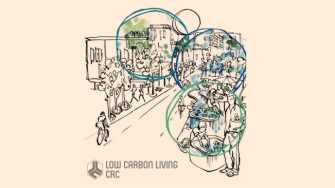Program 1: Integrated Building Systems

How can Australians build zero-carbon homes?
What is the best, and least costly, way to integrate design, new materials and technology to cut the carbon emissions Australian homes produce back to zero? That is the question a project at the University of South Australia has set itself to answer. The researchers are not looking only at new homes, but also at ways to renovate existing homes to reach the zero-carbon housing (ZCH) goal in the Australian climate.
The project, entitled 'Viable integrated systems for zero carbon housing', will monitor the evidence from projects to establish what regulations would be needed to bring emissions from Australian housing down to zero.
The project’s objectives are:
- to evaluate and integrate the effects of available and new design features, materials and technologies on reducing energy use and associated carbon emissions for both new and existing dwellings
- to evaluate the technological and economic effects of thermal and electrical storage and other demand management technologies on smoothing peak power demand
- to work with industry to demonstrate the effectiveness of the integrated approach in creating exemplar homes
- to develop the evidence base building regulators need for the environmental, economic and social costs and benefits of low-carbon homes.
- to develop, validate and test an integrated design algorithm that provides users with technically rigorous information on energy, carbon and economic effects during the design and renovation stages of a building and how these effects can be minimised under Australian climatic conditions.
- to investigate the suitability of the algorithm for mandatory and best-practice performance standards.
Prof Wasim Saman, UniSA
Complete
10/2012 to 10/2013
- Publications
- Posters
- News
- Partners
CRCLCL Project Reports
RP1006: Lochiel Park Monitoring Case Study
This report delivers a part of the first year outputs of RP1006: Viable Integrated Systems for Zero Carbon Housing, including a review of national and international house energy rating schemes and a review of Australian and some international residential energy monitoring program case studies. It focuses on one of the foremost Australian-based housing energy monitoring programs, the Lochiel Park Green Village in South Australia, which is Australia's leading sustainable housing development. It summarises the energy consumption and on site generation data collected the estate and discusses the overall performance of the houses, based on a continuous monitoring period of 24 months.
The case study demonstrates that low energy housing is currently achievable and highlights that modern design concepts and building practices can significantly reduce the energy demand for new houses and dependence on utility infrastructure and (typically) fossil fuel derived energy sources.
RP1006: Viable Integrated Systems for Zero Carbon Housing, 2013 Progress Report
RP1006 was established to support the path to zero carbon housing (ZCH) by focusing on the development and validation of evidence-based building energy modelling tools to support the regulatory pathway to zero emission housing in Australia. The 2013 Progress Report provides an update on progress against milestones including a scoping study of available house energy rating tools and a scoping study of residential energy end-use monitoring.
CRCLCL Project Posters
Research Snapshot Poster - RP1006
Research Snapshot A3 size poster from Participants Annual Forum 2014.
News articles
CRCLCL in the EconoTimes: Low-energy homes don't just save money, they improve lives
21 July 2017
Household energy use is a significant contributor to global carbon emissions. International policy is firmly moving towards technology-rich, low- and near-zero-energy homes. That is, buildings designed to reduce the need for additional heating, cooling and lighting. They use efficient or renewable energy technology to reduce the remaining energy use.
But what about the experiences of people who live in homes of this standard? Are these homes comfortable, easy to operate, and affordable? Do people feel confident using so-called smart energy technology designed for low energy use? What support systems do we need to help people live in low-energy, low-carbon houses?
Summary Update from Workshop 24 May 2013
At the University of South Australia’s city west campus on 24 May 2014, a project workshop was held to discuss the research needed to facilitate the transition to viable zero-carbon housing.
Partners on this project
- University of South Australia
- UNSW Sydney
- The University of Melbourne
- Renewal SA (Government of South Australia)
- NSW Planning & Infrastructure
- CSR
- CSIRO